The Synergistic Effect of the Filtration Area Controlled by the Electromagnetic Valve and Injection Pressure on Pulse-Jet Dust Cleaning Performance
Abstract
:1. Introduction
2. Experimental Equipment and Methods
2.1. Experimental Apparatus
2.2. Experimental Preparation
2.3. Experimental Designs
3. Results and Discussion
3.1. Research on the Peak Pressure Law
3.2. Dust-Cleaning Intensity
3.3. Ash Removal Uniformity and One Injection of the Electromagnetic Valve
4. Conclusions
Author Contributions
Funding
Institutional Review Board Statement
Informed Consent Statement
Data Availability Statement
Acknowledgments
Conflicts of Interest
References
- Pang, L.; Cao, J.; Xiao, Q.; Yang, K.; Shi, L. Explosion propagation in a dust removal pipeline under dust collector explosion. J. Loss Preven. Proc. 2021, 74, 104662. [Google Scholar] [CrossRef]
- Furumoto, K.; Narita, T.; Fukasawa, T.; Ishigami, T.; Kuo, H.P.; Huang, A.N.; Fukui, K. Influence of pulse-jet cleaning interval on performance of compact dust collector with pleated filter. Sep. Purif. Technol. 2021, 279, 119688. [Google Scholar] [CrossRef]
- Li, S.; Zhou, F.; Xie, B.; Wang, F. Influence of injection pipe characteristics on pulse-jet cleaning uniformity in a pleated cartridge filter. Powder Technol. 2018, 328, 264–274. [Google Scholar] [CrossRef]
- Meinke, P.; Raether, T. Evolution of cartridge dust collecting technology. Sep. Purif. Technol. 2002, 39, 24–26. [Google Scholar]
- Yan, C.P.; Zhang, M.X.; Lin, L.Y.; Chen, H. An analysis of a reverse pulse cleaning process using high-flow pleated fabric filter cartridges. Process Saf. Environ. 2018, 113, 264–274. [Google Scholar]
- Ren, L.; Yuan, N.; Lin, L.; He, C.; Tang, C.; Xu, Z. Effect of jet airfow defection on cleaning performance of flter cartridge. Environ. Sci. Pollut. R. 2022, 29, 27510–27520. [Google Scholar] [CrossRef] [PubMed]
- Chen, S.W.; Chen, D.R. Annular-slit nozzles for reverse flow cleaning of pleated filter cartridges. Sep. Purif. Technol. 2017, 177, 182–191. [Google Scholar] [CrossRef]
- Zhang, Q.; Liu, D.; Hu, A.J.; Xu, H.L.; Chen, H.Y. Flow field and pressure characteristics in pulse-jet dust cleaning. Int. J. Environ. Sci. Technol. 2022, 20, 6735–6746. [Google Scholar] [CrossRef]
- Lin, L.; Liu, T.; Yuan, N.; Xu, Z.; Chen, H. Study on the influence of venturi on the cleaning performance of elliptical filter cartridge. Powder Technol. 2021, 377, 139–148. [Google Scholar] [CrossRef]
- Litchwark, J.O.; Winchester, J.; Nijdam, J.J. Design of pulse-jet systems for milk powder baghouses. Powder Technol. 2015, 284, 379–386. [Google Scholar] [CrossRef]
- Yuan, N.; Ren, L.; Wang, B.; Teng, D.; Li, P.; Xu, Z.; Li, Y.; Chen, H.; Lin, L. Experimental study on the effects of diversion device on pulse-jet cleaning of horizontal filter cartridge. Process Saf. Environ. 2021, 145, 247–254. [Google Scholar] [CrossRef]
- Tanabe, H.; Barros, P.M.; Rodrigues, K.B. Experimental investigation of deposition and removal of particles during gas filtration with various fabric filters. Sep. Purif. Technol. 2011, 80, 187–195. [Google Scholar] [CrossRef]
- Humphries, W.; Madden, J.J. Fabric filtration for coal-fired boilers: Dust disparagement in pulse jet filters. Filtr. Sep. 1983, 20, 40–44. [Google Scholar]
- Lǖ, J.; Yan, C.P.; Fu, Y.; Chen, H. Influence of injection pipe on dust-cleaning performance of bag filter. Chin. J. Environ. Eng. 2017, 3, 1667–1671. (In Chinese) [Google Scholar]
- Wang, Q.; Zhang, M.; Lai, X.; Chen, H.; Qian, Y. Effective dust cleaning intensity of high temperature filter bag. Chin. J. Environ. Eng. 2015, 9, 1318–1322. (In Chinese) [Google Scholar]
- Li, J.; Wu, D.; Wu, Q.; Luo, M.; Li, J. Design and performance evaluation of novel colliding pulse jet for dust filter cleaning. Sep. Purif. Technol. 2019, 213, 101–113. [Google Scholar] [CrossRef]
- Kavouras, A.; Krammer, G. A model analysis on the reasons for unstable operation of jet-pulsed filters. Powder Technol. 2005, 154, 24–32. [Google Scholar] [CrossRef]
- Tsai, C.J.; Lu, H.C. Numerical and experimental study of cleaning process in pulse-jet fabric filtration systems. J. Aerosol Sci. 1996, 30, 3243–3249. [Google Scholar] [CrossRef]
- Amano, H.; Watanabe, H.; Ikeno, H.; Suzuki, T.; Sintokogio Ltd. Apparatus for Collecting Dust and a Pleated-Type Filter Therefor. U.S. Patent No. 8,062,396, 22 November 2011. [Google Scholar]
- Döring, N.; Meyer, J.; Kasper, G. The influence of cake residence time on the stable operation of a high-temperature gas filter. Chem. Eng. Sci. 2009, 64, 2483–2490. [Google Scholar] [CrossRef]
- Yan, C.P.; Liu, G.J.; Chen, H.C. Effect of induced airflow on the surface static pressure of pleated fabric filter cartridges during pulse jet cleaning. Powder Technol. 2013, 249, 424–430. [Google Scholar] [CrossRef]
- Lu, H.C.; Tsai, C.J. A Pilot-Scale Study of the Design and Operation Parameters of a Pulse-Jet Baghouse. Aerosol. Sci. Technol. 1998, 29, 510–524. [Google Scholar] [CrossRef]
- Park, S.; Joe, Y.H.; Shim, J.; Park, H.; Shin, W.G. Non-uniform filtration velocity of process gas passing through a long bag filter. J. Hazard. Mater. 2019, 365, 440–447. [Google Scholar] [CrossRef] [PubMed]
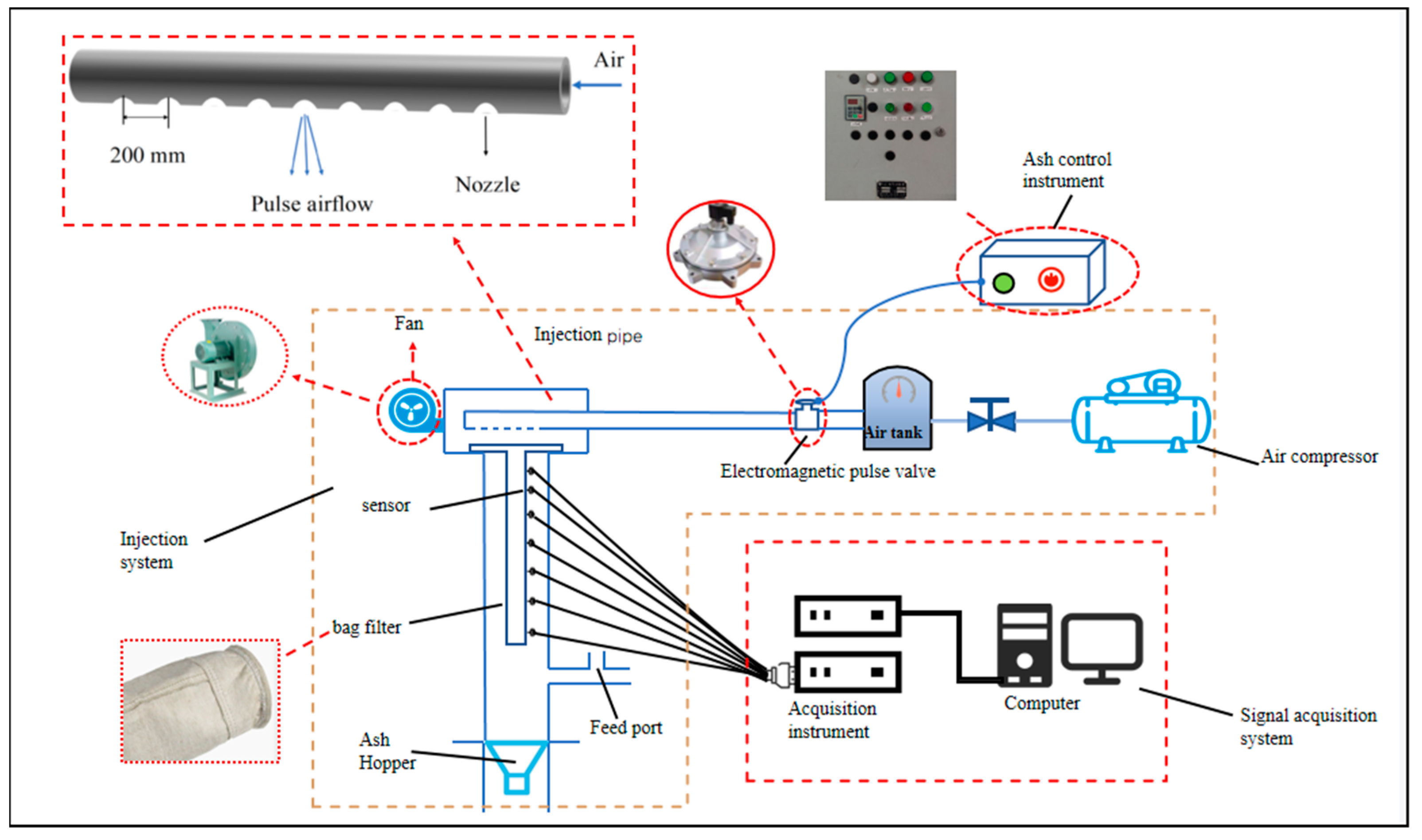
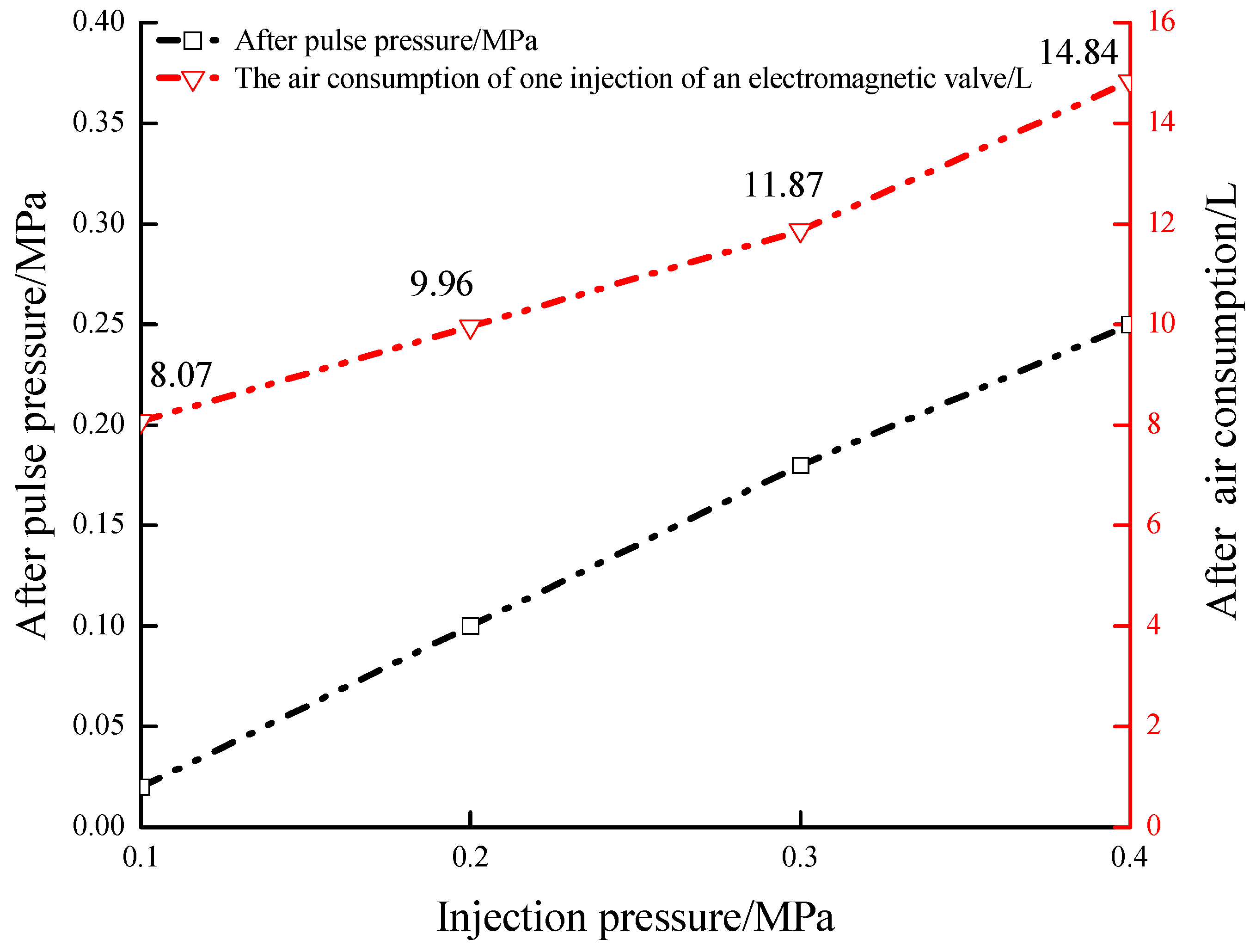

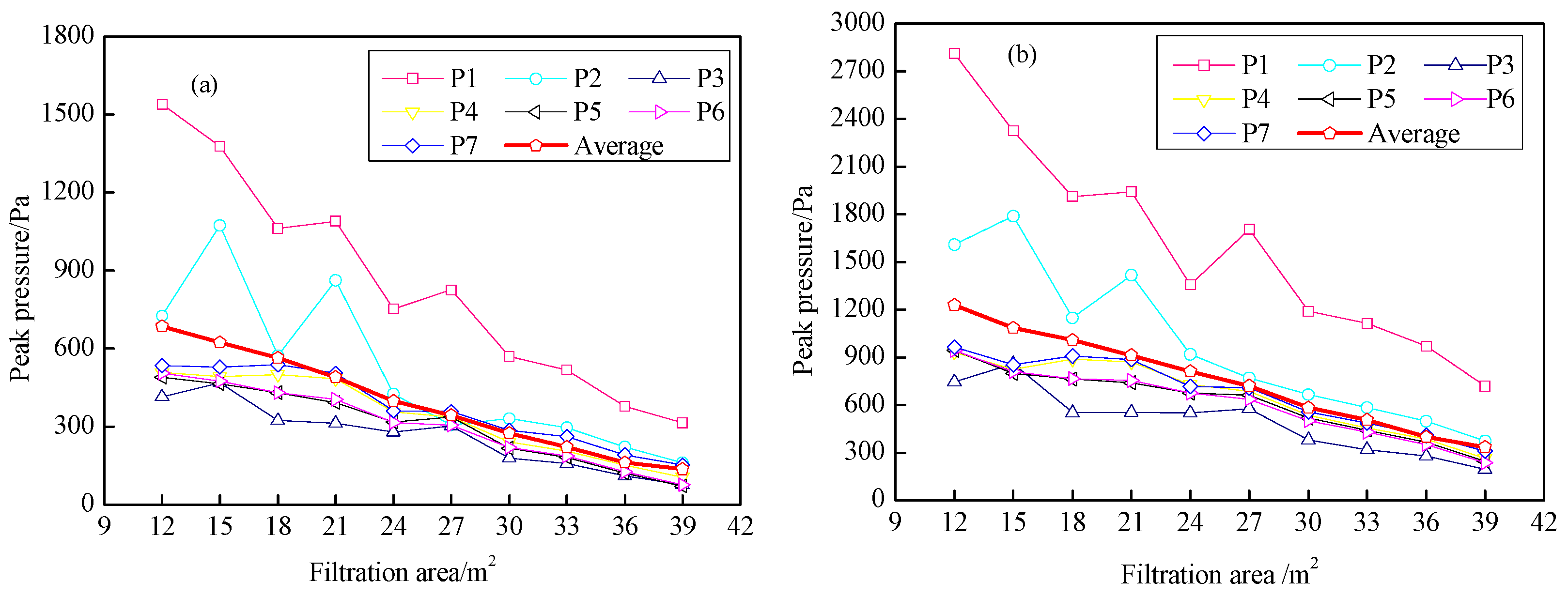
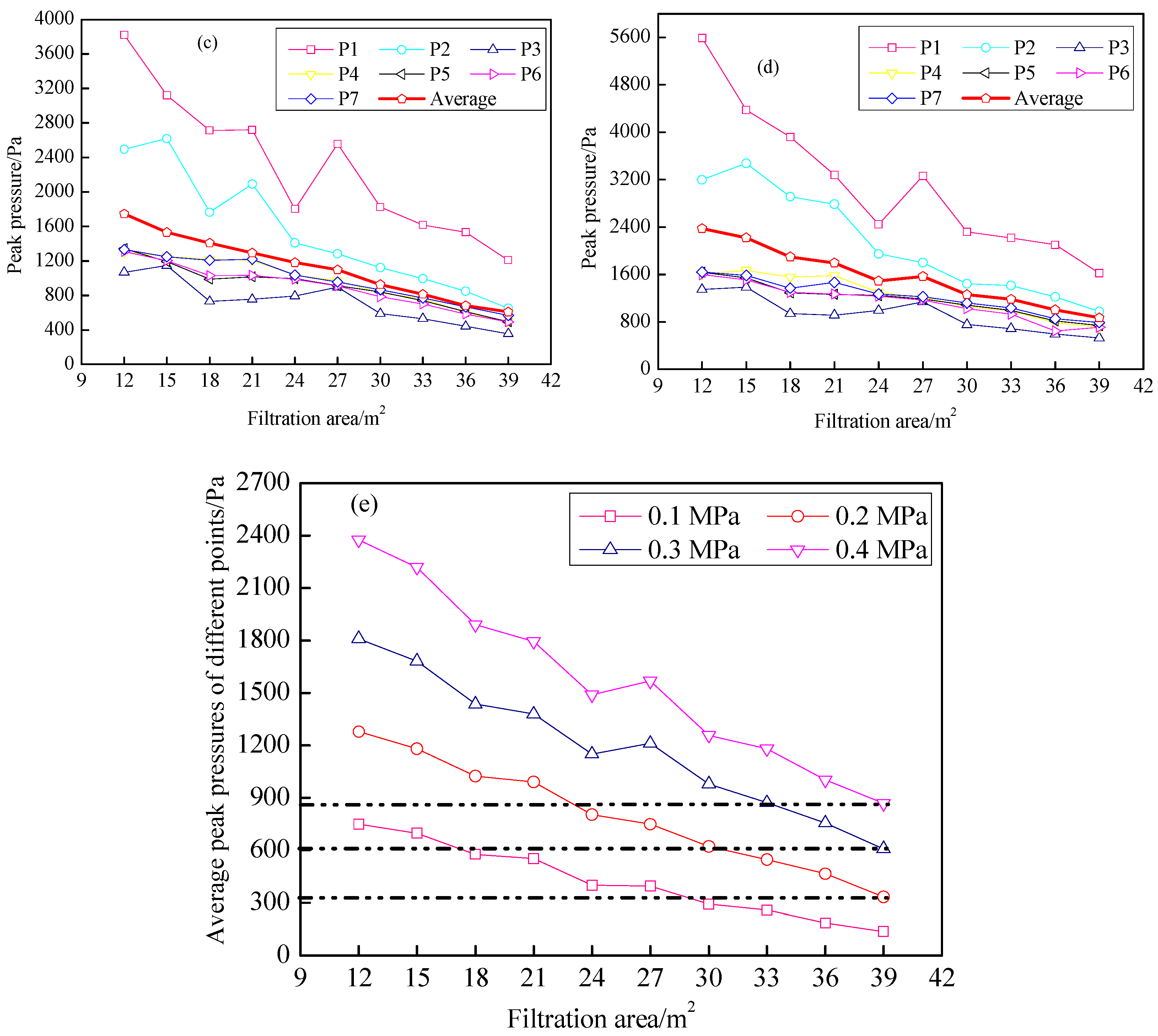
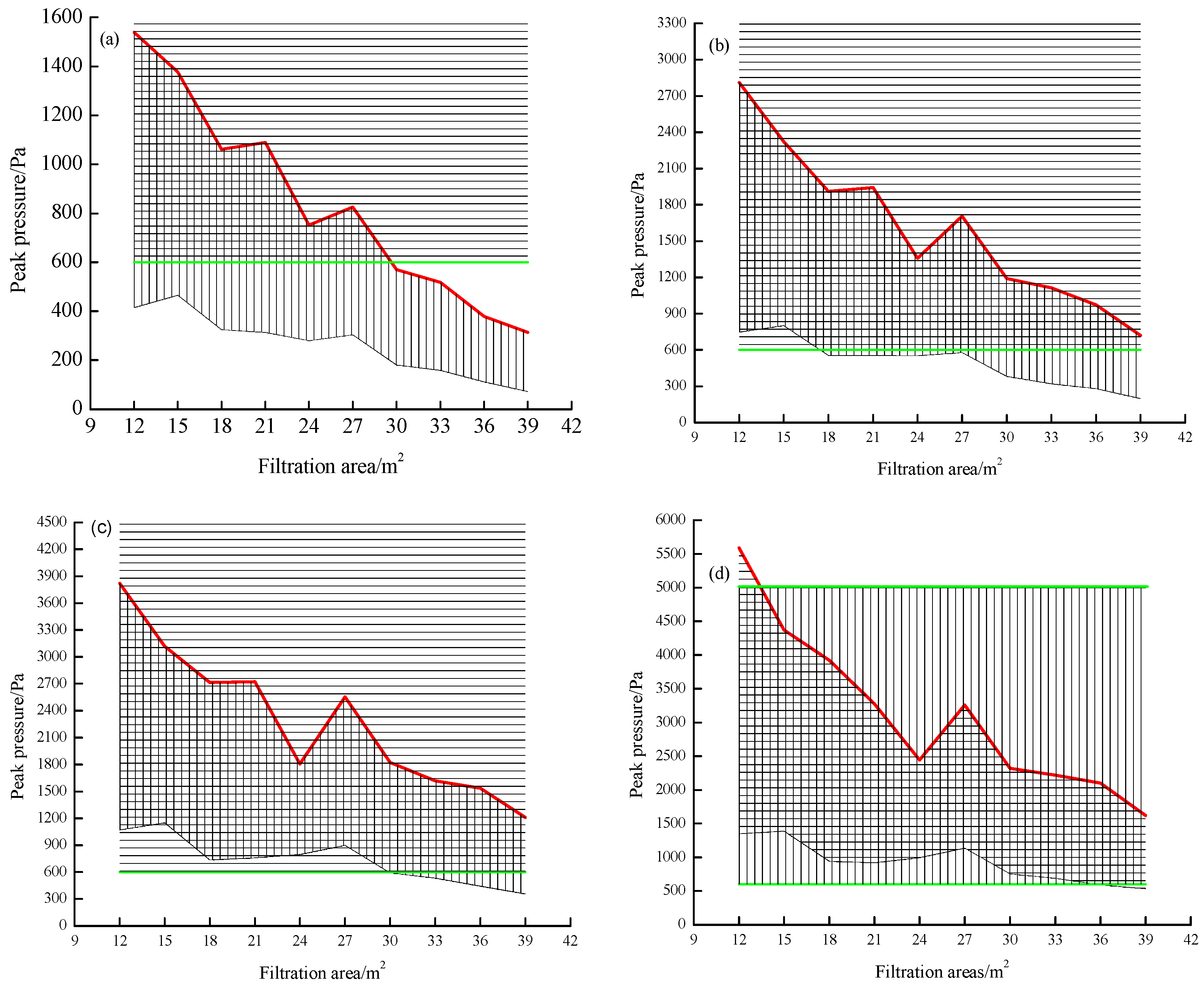
| Injection Pressures/(MPa) | Standard Deviation under Different Filtration Areas | |||||||||
|---|---|---|---|---|---|---|---|---|---|---|
| 12 m2 | 15 m2 | 18 m2 | 21 m2 | 24 m2 | 27 m2 | 30 m2 | 33 m2 | 36 m2 | 39 m2 | |
| 0.1 | - | - | - | - | - | - | - | - | - | - |
| 0.2 | 0.338 | 0.311 | - | - | - | - | - | - | - | - |
| 0.3 | 0.358 | 0.312 | 0.302 | 0.274 | 0.264 | 0.252 | - | - | - | - |
| 0.4 | - | 0.398 | 0.372 | 0.351 | 0.336 | 0.325 | 0.26 | 0.246 | - | - |
| Injection Pressures/(MPa) | A Variance under Different Filtration Areas | |||||||||
|---|---|---|---|---|---|---|---|---|---|---|
| 12 m2 | 15 m2 | 18 m2 | 21 m2 | 24 m2 | 27 m2 | 30 m2 | 33 m2 | 36 m2 | 39 m2 | |
| 0.1 | - | - | - | - | - | - | - | - | - | - |
| 0.2 | 0.114 | 0.096 | - | - | - | - | - | - | - | |
| 0.3 | 0.128 | 0.097 | 0.091 | 0.075 | 0.070 | 0.064 | - | - | - | - |
| 0.4 | - | 0.158 | 0.138 | 0.123 | 0.113 | 0.106 | 0.068 | 0.061 | - | - |
Disclaimer/Publisher’s Note: The statements, opinions and data contained in all publications are solely those of the individual author(s) and contributor(s) and not of MDPI and/or the editor(s). MDPI and/or the editor(s) disclaim responsibility for any injury to people or property resulting from any ideas, methods, instructions or products referred to in the content. |
© 2024 by the authors. Licensee MDPI, Basel, Switzerland. This article is an open access article distributed under the terms and conditions of the Creative Commons Attribution (CC BY) license (https://creativecommons.org/licenses/by/4.0/).
Share and Cite
Fu, Y.; Lǖ, J.; Huang, S.; Lin, L.; Chen, H. The Synergistic Effect of the Filtration Area Controlled by the Electromagnetic Valve and Injection Pressure on Pulse-Jet Dust Cleaning Performance. Atmosphere 2024, 15, 510. https://doi.org/10.3390/atmos15040510
Fu Y, Lǖ J, Huang S, Lin L, Chen H. The Synergistic Effect of the Filtration Area Controlled by the Electromagnetic Valve and Injection Pressure on Pulse-Jet Dust Cleaning Performance. Atmosphere. 2024; 15(4):510. https://doi.org/10.3390/atmos15040510
Chicago/Turabian StyleFu, Yu, Juan Lǖ, Shenglong Huang, Longyuan Lin, and Haiyan Chen. 2024. "The Synergistic Effect of the Filtration Area Controlled by the Electromagnetic Valve and Injection Pressure on Pulse-Jet Dust Cleaning Performance" Atmosphere 15, no. 4: 510. https://doi.org/10.3390/atmos15040510





